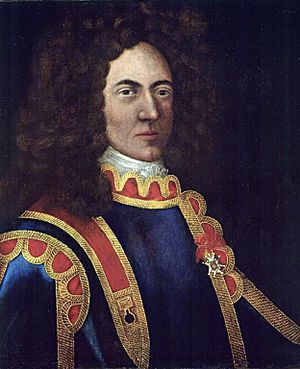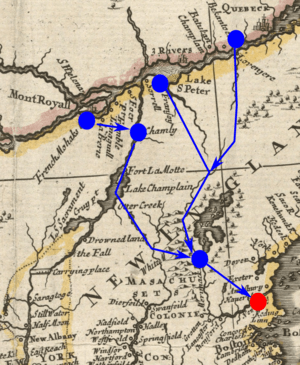Raid on Haverhill (1708) facts for kids
Quick facts for kids Raid on Haverhill |
|||||||
|---|---|---|---|---|---|---|---|
| Part of Queen Anne's War | |||||||
 Jean-Baptiste Hertel de Rouville, French commander |
|||||||
|
|||||||
| Belligerents | |||||||
Algonquin Montagnais |
|||||||
| Commanders and leaders | |||||||
| Simon Wainwright † Major Turner Samuel Ayer † |
Jean-Baptiste Hertel de Rouville Chief Escumbuit |
||||||
| Strength | |||||||
| 70+ militia | 250 native warriors and French Canadian militia | ||||||
| Casualties and losses | |||||||
| 16 killed, 14–24 militia and inhabitants captured | 9 killed 18 wounded |
||||||
The Raid on Haverhill was a surprise attack that happened on August 29, 1708. It was part of a bigger conflict called Queen Anne's War. During this raid, French soldiers and Native American warriors attacked the small town of Haverhill. At that time, Haverhill was a frontier community in the Province of Massachusetts Bay.
The attackers were led by Jean-Baptiste Hertel de Rouville. In the raid, 16 people from Haverhill lost their lives. Also, between 14 and 24 people were captured. Local defenders quickly gathered and chased the attackers. In a fight later that day, nine of the French and Native American group were killed. Some of the captured people managed to escape during this chase.
Haverhill was not the first choice for this attack. French leaders had planned a larger series of raids. They wanted to attack towns along the Piscataqua River. However, some Native American tribes decided not to join the expedition. This forced the French to make their plan smaller. They chose an easier target, which turned out to be Haverhill. This raid ended up costing the French more lives than earlier attacks, like the one on Deerfield in 1704. This was because the people in Massachusetts had been warned that an attack might be coming.
Contents
Understanding the Background of the Raid
When Queen Anne's War began in 1702, it caused fighting on the border. This border was between the English colonies of New England and the French colonies of New France. New France included areas like Acadia and Canada.
French military officers often led groups of Native Americans. These groups traveled south from their homes along the Saint Lawrence River. They went to the northern borders of New England. These areas now include parts of northern Massachusetts, southern New Hampshire, and Maine.
Previous Attacks and Plans
The biggest and most successful raid of the war happened in February 1704. Jean-Baptiste Hertel de Rouville led about 250 men, mostly Native Americans. They attacked the frontier town of Deerfield. Hertel de Rouville's group killed or captured many townspeople. They then returned to Canada on a very hard journey. Many prisoners died on this trip. Some who survived were adopted into Native American communities.
After this, Massachusetts made its border defenses stronger. They used local soldiers called militia. They also launched their own attack against Acadia.
The village of Haverhill had also faced smaller attacks in 1704. However, it was not the main target for a big plan made by New France's Governor-General Philippe de Rigaud Vaudreuil in 1708. Vaudreuil wanted to put more pressure on the New England colonies. He also worried that Native Americans were trading too much with Province of New York. This was hurting New France's economy. So, Vaudreuil decided to plan a major raid. He wanted it to be even bigger than the Deerfield attack.
Vaudreuil's plan was to gather about 400 men. They would attack towns in New Hampshire along the Piscataqua River. To keep the plan secret, groups would travel from different places. They would meet at Lake Winnipesaukee. The main French group left from Trois-Rivières. It had about 100 men, including Canadian militia and soldiers. This group was led by Hertel de Rouville. Many veterans from the Deerfield raid were with him. They were joined by Abenaki and Nipissing people.
Another group of 220 Iroquois was to leave Montreal. They were led by René Boucher de La Perrière. More Huron and Abenaki people were to come from near Quebec.
News about this big plan reached Albany, New York, through Native American traders. From there, the news went to Boston. Because no one knew the exact targets, it was hard to prepare specific defenses. About 40 provincial militia were sent to Haverhill after these reports.
Challenges for the Expedition
Parts of the expedition started their journey in mid-July. As the Quebec group traveled, a Huron person died in an accident. Many Native Americans saw this as a bad sign. Because of this, the Hurons turned back. Among the Iroquois from Montreal, some men got sick. The rest refused to continue. Some people at the time thought this was a trick by the Iroquois to avoid fighting.
Vaudreuil believed this was the case. Reports reached the English that the Iroquois had chosen to leave the expedition. They did not want to "join war against New England." Despite these problems, Vaudreuil told Hertel de Rouville to keep going. He was to continue even if he got no more help. When his group reached Lake Winnipesaukee, he found no eastern Native Americans willing to join. Hertel de Rouville was left with only about 160 men. This meant he had to choose targets that were not as well defended.
Why Haverhill Was Chosen
Haverhill was chosen for a few reasons. The village layout was already known from the 1704 raids. It was also known from an earlier raid during the Nine Years' War. Haverhill was not very large, with only about 25 to 30 houses. Its location also made it hard to defend. Only some of the houses were fortified. A fast-moving raiding party could attack and leave quickly. They could be gone before a full alarm was raised.
The group arrived outside Haverhill and got ready to attack on Sunday, August 29. At some point, the exiled Abenaki war chief Escumbuit joined them. He lived near Haverhill and had heard about the expedition.
At that time, Haverhill's defense was split. The local militia was led by Simon Wainwright. His house had a view of the whole village. The town's defenses also had three small groups of colonial troops. Each group had three to four men. Major Turner was in charge of these troops.
The Raid on Haverhill
The attackers successfully snuck past the outer groups of provincial militia. A villager first saw them in the early morning light. He fired his gun to raise the alarm. He ran towards the village, with the French and Native Americans chasing him noisily. The attack quickly spread as the raiders moved through the houses.
One group of colonial soldiers was in the home of the minister, Benjamin Rolfe. He had locked the door to try and keep the raiders out. Raiders shot through the door, wounding Rolfe. Then they broke the door down. They then killed Rolfe, his wife, their baby, and the colonial soldiers. In another house, a baby was thrown through an open window by an attacker but was not hurt. Many villagers escaped by hiding in cellars. The attackers did not find their hidden trapdoors. Captain Wainwright was getting ready to organize a defense. But gunfire from the raiders came through his door, killing him instantly.
The raiding and stealing continued. Then, the raiders heard the sounds of more militia companies coming. They quickly set the town meetinghouse on fire. Then they left with the people they had captured and their stolen goods. The new soldiers came from nearby towns, some from as far as Salem. They gathered under Major Turner's command when they arrived.
One group of Haverhill militiamen found the raiders' baggage camp a few miles from the village. They took their packs. Captain Samuel Ayer's company, about 20 men, chased the retreating raiders. More militia joined them, making the group stronger. They then fought the raiders, who were slowed down by their prisoners and loot. In a fierce fight, the raiders fought off the militia. Captain Ayer was killed in this action. The raiders lost nine men, including Hertel de Rouville's brother. Eighteen more were wounded. Because of this fight, the raiders left some of their stolen goods. Some of their prisoners also got away. The village recorded that 30 to 40 people were killed or captured. This number included those who escaped later.
What Happened After the Raid
The raiders' journey back to Canada was very hard. Joseph Bartlett, one of their captives, described the difficulties. These problems were due to losing their supplies. One day, they caught a hawk. It was divided among 15 men. Bartlett's share was the head, which he said was "the largest meal I had these four days." Bartlett stayed captured by the Native Americans for four years. Some of the Frenchmen, instead of trying to travel without their supplies, surrendered to Massachusetts authorities.
French reports of the raid greatly exaggerated the numbers. They claimed that several hundred people had been killed. They also said that the fight after the raid involved as many as 200 English colonists. This raid was more costly for the French than earlier ones. Because the Massachusetts militia was better prepared, the French had a higher number of casualties than in the Deerfield raid.
This raid was the last large-scale attack the French launched against Massachusetts during the war. Smaller attacks happened along the border. Wells, which was then part of Massachusetts, was attacked by a large force in 1712. Port Royal fell in 1710 to an expedition that included British marines. The British gave up on a 1711 naval expedition against Quebec. This was after some of their troop ships ran aground at the mouth of the St. Lawrence River, leading to many deaths.


